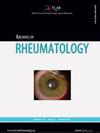贝利木单抗在系统性红斑狼疮患者标准治疗之外的早期有效性和安全性分析
IF 1.1
4区 医学
Q4 Medicine
引用次数: 0
摘要
研究目的本研究旨在评估贝利木单抗在系统性红斑狼疮(SLE)患者中作为标准疗法的补充,持续24周的早期有效性和安全性。患者和方法这项回顾性研究在2020年6月至2022年8月期间对60名活动性系统性红斑狼疮成年患者进行了研究。患者要么在接受标准疗法的基础上静脉注射贝利木单抗(31人;24名女性,7名男性;平均年龄:33.7±14.1岁;年龄范围:18至52岁),要么只接受标准疗法(29人;22名女性,7名男性;平均年龄:34.1±13.4岁;年龄范围:19至66岁),疗程为24周。结果测量包括安全性和有效性(雌激素在红斑狼疮中的安全性国家评估-系统性红斑狼疮疾病活动指数[SELENA-SLEDAI])、生物标志物(双链DNA[脱氧核糖核酸])的变化、血清补体水平和免疫球蛋白G(IgG)。还记录了不良事件。结果两组患者的基线人口统计学特征和临床特征相似。在第12周和第24周,贝利木单抗组有更多患者的SELENA-SLEDAI降低了≥4分(第12周,77.4%对41.4%,P=0.008;第24周,87.1%对48.3%,P=0.002)。在第12周时,贝利木单抗组的SELENA-SLEDAI平均得分明显低于标准疗法组。然而,在第24周时,差异并不明显。此外,在第12周和第24周时,贝利木单抗组血清C3和C4的平均水平明显高于标准疗法组。与标准疗法组相比,贝利木单抗组中C3水平正常的患者比例更高。此外,在第12周和第24周,贝利木单抗治疗导致IgG水平显著下降。第24周时,与标准疗法组相比,贝利木单抗组的泼尼松剂量减少幅度更大。此外,在第12周时,泼尼松较基线减少50%以上的患者比例,贝利木单抗组明显高于标准疗法组(p=0.002)。两组的不良反应发生率相似(标准疗法组,44.8%;贝利姆单抗组,51.6%)。结论中国系统性红斑狼疮患者对静脉注射贝利木单抗的耐受性良好,并能在治疗早期显著改善疾病活动度。更重要的是,贝利木单抗治疗可使泼尼松剂量在第12周时迅速减少。本文章由计算机程序翻译,如有差异,请以英文原文为准。
Early effectiveness and safety analysis of belimumab in addition to standard treatment in patients with systemic lupus erythematosus
Objectives: This study aimed to evaluate the early effectiveness and safety of belimumab in addition to standard therapy in patients with systemic lupus erythematosus (SLE) for 24 weeks.
Patients and methods: This retrospective study was conducted with 60 adult patients with active SLE between June 2020 and August 2022. The patients either received intravenous belimumab in addition to standard therapy (n=31; 24 females, 7 males; mean age: 33.7±14.1 years; range, 18 to 52 years) or only standard therapy (n=29; 22 females, 7 males; mean age: 34.1±13.4 years; range, 19 to 66 years) for 24 weeks. Outcome measures, including safety and effectiveness (Safety of Estrogens in Lupus Erythematosus National Assessment–Systemic Lupus Erythematosus Disease Activity Index [SELENA-SLEDAI]), changes in biomarkers (double-stranded DNA [deoxyribonucleic acid]), serum complement levels, and immunoglobin G (IgG) were recorded. Adverse events were recorded.
Results: Baseline demographic and clinical characteristics were similar between the two groups. More patients in the belimumab group achieved a reduction of ≥4 points in SELENA-SLEDAI at weeks 12 and 24 (week 12, 77.4% vs. 41.4%, p=0.008; week 24, 87.1% vs. 48.3%, p=0.002). The mean score of SELENA-SLEDAI was significantly lower in the belimumab group compared to the standard therapy group at week 12. However, a significant difference was not reached at week 24. Moreover, mean levels of serum C3 and C4 in the belimumab group were significantly higher than those in the standard therapy group at weeks 12 and 24. A higher proportion of patients in the belimumab group had a normal C3 level than in the standard therapy group. In addition, belimumab treatment resulted in a significant decrease in IgG levels at both weeks 12 and 24. At week 24, the belimumab group had a higher reduction in prednisone dose than the standard therapy group. Furthermore, the percentages of patients with more than 50% reduction in prednisone over baseline were significantly greater for belimumab versus standard therapy at week 12 (p=0.002). The occurrence of adverse events was similar between the two groups (standard therapy group, 44.8%; belimumab group, 51.6%).
Conclusion: Intravenous belimumab was well tolerated and significantly improved disease activity in Chinese patients with SLE at the early stage of treatment. More importantly, belimumab treatment could result in a rapid reduction in prednisone dose as early as week 12.
求助全文
通过发布文献求助,成功后即可免费获取论文全文。
去求助
来源期刊

Archives of rheumatology
Medicine-Rheumatology
CiteScore
2.00
自引率
9.10%
发文量
15
期刊介绍:
The Archives of Rheumatology is an official journal of the Turkish League Against Rheumatism (TLAR) and is published quarterly in March, June, September, and December. It publishes original work on all aspects of rheumatology and disorders of the musculoskeletal system. The priority of the Archives of Rheumatology is to publish high-quality original research articles, especially in inflammatory rheumatic disorders. In addition to research articles, brief reports, reviews, editorials, letters to the editor can also be published. It is an independent peer-reviewed international journal printed in English. Manuscripts are refereed by a "double-blind peer-reviewed" process for both referees and authors.
Editorial Board of the Archives of Rheumatology works under the principles of The World Association of Medical Editors (WAME), the International Council of Medical Journal Editors (ICMJE), and Committee on Publication Ethics (COPE).
 求助内容:
求助内容: 应助结果提醒方式:
应助结果提醒方式:


